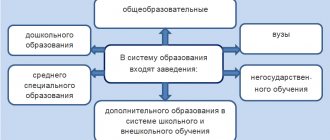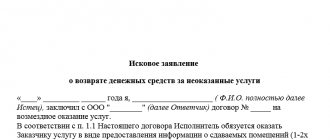What is a tax deduction for treatment?
According to the legislation of the Russian Federation (Article 219 of the Tax Code of the Russian Federation), when paying for treatment or medications, you can count on a tax deduction and return part of the money spent on treatment .
A tax deduction is the portion of income that is not subject to tax. Therefore, you can return the tax paid on the expenses incurred for treatment. If you officially work and pay income tax, have paid for your treatment or the treatment of your relatives , you can get back part of the money in the amount of up to 13% of the cost of treatment .
Who will not be able to count on tax compensation?
In addition to non-residents and the unemployed, a tax deduction is not provided if treatment and medicines were paid for:
- pensioners who do not continue to work;
- parents for children over 18 years of age;
- an employer for his employee;
- a relative with a different degree of relationship than marital and parental relationships (for example, a grandson for a grandmother, etc.);
- an entrepreneur who is under one of the special taxation regimes that does not provide for the payment of income tax (STS, UTII).
ATTENTION! Also, you should not count on a deduction if during a given tax period you did not have income taxed at a rate of 13%, even if you incurred treatment expenses.
In what cases can you get a tax deduction for treatment?
You can take advantage of the social tax deduction for treatment and get part of your expenses back in the following cases:
- You can get a tax deduction when paying for medical services, If:
- paid for services for their own treatment or treatment of close relatives (spouse, parents, children under 18 years of age) provided by medical institutions in Russia;
- paid services are included in a special list of medical services for which a deduction is provided. The list of services is defined in Decree of the Government of the Russian Federation dated March 19, 2001 N 201.
- the treatment was carried out in a medical institution licensed to carry out medical activities;
- You can get a tax deduction when paying for medicines, If:
- paid at their own expense for medications for themselves or their immediate relatives (spouse, parents, children under 18 years of age) prescribed by the attending physician.
- You can get a tax deduction when paying for voluntary health insurance, If:
- paid insurance premiums under a voluntary health insurance agreement or insurance for immediate relatives (spouse, parents, children under 18 years of age);
- the insurance contract only provides for payment for treatment services;
- the insurance organization with which the voluntary insurance agreement has been concluded has a license to conduct the corresponding type of activity.
Certificate from a medical institution
When submitting documents to the tax office for a personal income tax refund for treatment, special attention should be paid to the certificate issued by the medical institution.
This paper will be needed if medical expenses have been paid.
IMPORTANT! The form of the certificate of payment for medical services was approved by order of the Ministry of Health and the Ministry of Taxes of Russia dated July 25, 2001 No. 289/BG-3-04/256.
At the same time, other documents confirming the fact of payment (receipts, checks, bills, etc.) are not needed, since this certificate is issued only if the services have already been paid for. This position is shared by both officials of the Ministry of Finance and tax authorities (letters of the Ministry of Finance of Russia dated March 29, 2018 No. 03-04-05/20083, dated April 17, 2012 No. 03-04-08/7-76, Federal Tax Service of Russia dated March 7, 2013 No. ED- 3-3/ [email protected] ).
See the material “Certificate or checks for treatment? The Ministry of Finance says - a certificate.”
Such a certificate can also be obtained after undergoing sanatorium-resort treatment. At the same time, it will not indicate the cost of the voucher, but only the price of treatment (less expenses for food, accommodation, etc.) and the amount of additionally paid medical services.
If you have the above certificate and the type of service provided is included in the list, to receive a deduction you will need 2 more documents from the medical institution that provided the service: a contract and a license. If the medical institution does not have a license to carry out medical activities or the treatment was carried out not by a Russian, but by a foreign clinic, the deduction will be denied.
Tax officials must provide a certified copy of the agreement with the medical institution. Particular attention should be paid to the terms of this document if expensive treatment was carried out, and you purchased materials or medical equipment at your own expense that were not available in this clinic. This will allow you to receive a full deduction.
The license is presented in the form of a certified copy. It is not necessary to attach a license separately if its details are specified in the contract.
Amount of tax deduction for treatment
The amount of tax deduction for treatment is calculated for the calendar year and is determined by the following factors:
- You cannot return more money than you transferred to the income tax budget (about 13% of the official salary).
- You can return up to 13% of the cost of paid treatment/medicines , but not more than 15,600 rubles . This is due to the restriction on the maximum deduction amount of 120 thousand rubles (120 thousand rubles * 13% = 15,600 rubles). The limit of 15,600 rubles applies not only to deductions for treatment, but to all social deductions. The amount of all social deductions (training, treatment, pension contributions) should not exceed 120 thousand rubles. You can return a maximum of 15,600 rubles for all deductions).
- There is a certain list of expensive medical services to which the limit of 15,600 rubles does not apply . You can receive a tax deduction and get 13% back on the full cost of such services in addition to all other social deductions. The full list of expensive services is defined in Decree of the Government of the Russian Federation of March 19, 2001 N 201. You can find it here: List of expensive types of treatment
Example : In 2021 Ivanov A.A. paid for a course of dental treatment worth 140 thousand rubles and a paid operation related to expensive treatment costing 200 thousand rubles. At the same time, in 2021 he earned 500 thousand rubles and paid income tax of 62 thousand rubles.
Since dental treatment is not an expensive treatment, the maximum tax deduction for it is 120 thousand rubles (which is less than 140 thousand rubles). Since the operation of Ivanov A.A. refers to expensive types of treatment, there are no restrictions on tax deductions for it.
Total in 2021 for 2021 Ivanov A.A. will be able to return to himself (120 thousand rubles + 200 thousand rubles) * 13% = 41,600 rubles. So Ivanov A.A. paid taxes more than 41,600 rubles, he will be able to return the entire amount.
Additional and more complex examples of calculating a tax deduction for treatment can be found here: Examples of calculating a tax deduction for treatment
How many times and how often can I apply for a deduction?
The full cost of treatment should be indicated, even if it exceeds the possible deduction
You can apply for a tax deduction once a year. Since each time the declaration is submitted for the year that ended (i.e. in 2021 documents for 2017 are submitted), the deduction is issued for the same year.
The period during which you can submit documents is 3 years (i.e. in 2018 you can receive a deduction for 2021, 2021 and 2015).
The full cost of treatment should be indicated, even if it exceeds the possible deduction.
If treatment occurred at the end of one year and the beginning of another, then the declaration indicates only the amount spent in the past year.
If a citizen has already applied for tax deductions in previous years, this does not prevent him from applying for this type of refund. You can receive several types of deductions in one year, but their total amount is limited.
The process of obtaining a deduction for treatment
The process of obtaining a deduction for treatment consists of collecting and submitting documents to the tax office, checking the documents by the tax office and transferring money. You can learn more about the process of obtaining a tax deduction, indicating the deadlines, here: The process of obtaining a tax deduction for treatment.
The process of obtaining a deduction can be simplified by using our service. We will fill out the 3-NDFL declaration for you, tell you what other documents you will need for the deduction, and also give detailed instructions on submitting documents to the tax authorities. Or we will send your documents ourselves, without your participation. If you have any questions while working with the service, tax experts will be happy to advise you.
Birth certificate and other documents
A birth certificate will need to be submitted in the package of documents for deduction in 2 cases:
- if the deduction applicant wants to return the money spent on the treatment of children, the child’s birth certificate will be required;
- if the applicant’s parents were treated and the applicant paid for their treatment, the applicant’s birth certificate must be attached.
If the deduction is issued for the treatment expenses of the applicant's spouse, you will have to provide a marriage certificate.
All of the above evidence is needed to confirm the degree of relationship between the person who spent the money and the recipient of the medical service. They are transferred to the tax authorities in the form of certified copies.
IMPORTANT! Copies of documents for filing a tax deduction can be certified in 2 ways: notarized or independently by the deduction applicant (on each page of all documents you must write: “Copy is correct,” sign, decipher the signature and date it).
For information on income not taken into account when calculating personal income tax, read the article “Income not subject to personal income tax taxation (2019 - 2020).”
Having collected all the necessary documents, you can begin to prepare the 3-NDFL declaration. Our article will help you with this.
Documents required to apply for a tax deduction for treatment
To apply for a tax deduction, you will first need:
- declaration 3-NDFL;
- agreement with a medical institution;
- certificate of payment for medical services;
- documents confirming your expenses;
- documents confirming the paid income tax (certificate 2-NDFL).
You can view the full list of documents here: Documents for tax deductions for treatment.
What documents are needed to receive an income tax refund for treatment?
Declaration 3-NDFL, application for deduction, certificate of income 2-NDFL, passport - with this set of documents any person who decides to exercise his right to receive a refund of personal income tax from the amounts spent on treatment will need to start processing the deduction.
IMPORTANT! The possibility of a tax deduction for treatment expenses is provided for in subparagraph. 3 p. 1 art. 219 of the Tax Code of the Russian Federation.
To ensure that collecting documents for a tax deduction for treatment does not turn into a waste of time, you first need to check whether all legally established conditions and restrictions associated with the use of a social deduction are met, clarifying the following points:
- The person who paid the medical expenses and received the medical service is the same person or the indicated persons are close relatives.
IMPORTANT! Close relatives are considered to be parents, spouses and children under the age of 18 (including adopted children and wards). See also “You can receive social benefits if the person ordering the treatment is your spouse.”
- The person who paid the medical expenses and the deductible claimant are the same person.
IMPORTANT! If the treatment was paid for by the company, the tax authorities will refuse the deduction.
- The taxpayer claiming the deduction has income taxed at a rate of 13% and paid personal income tax to the budget.
IMPORTANT! Pensioners or individual entrepreneurs using the simplified tax system and UTII will be able to claim a deduction only if they have income taxed at a rate of 13%.
If the above conditions are met, you can safely begin collecting the following documents to deduct personal income tax for treatment (this will be discussed below).
You can familiarize yourself with the procedure for filling out the 3-NDFL declaration in the article “Sample of filling out the 3-NDFL tax return” .
When and for what period can I receive a tax deduction?
You can get your money back for treatment only for those years in which you paid directly. However, you can submit a declaration and return the money through the tax office only in the year following the year of payment or later. That is, if you paid for treatment in 2021, you will be able to return the money no earlier than 2021.
If you did not file a deduction immediately, you can do it later, but you can return the tax for no more than the last three years. For example, if you paid for treatment in 2016-2020 and did not receive a tax deduction, then in 2021 you can get your tax back only for 2021, 2021 and 2021.
The entire procedure for obtaining a deduction usually takes three to four months. Most of the time is spent checking documents by the tax office.
Note: from January 1, 2021, a social tax deduction for treatment can be obtained through an employer, and there is no need to wait until the end of the calendar year. You can find details about receiving a deduction through an employer in our article: Obtaining a tax deduction for treatment through an employer.
Is it possible to receive a deduction several times within one year?
This question arises when treatment is paid for several times during the year. It doesn’t matter whether you continue your own treatment, whether you need additional procedures and medications, or whether your relative gets sick.
To confirm your right to the deduction, contact the tax office for notice to the employer as many times as required.
But remember that within one year the total amount of social deductions cannot be more than 120 thousand rubles. That is, the maximum amount for return is 15.6 thousand rubles.
Example:
Let's say in February 2021 you were treated in a paid clinic. In April, after checking your documents, you receive a notice from the tax office and give it to your employer. From this moment on, the accounting department suspends the withholding of personal income tax from your salary.
Then, in June of the same year, you pay for the installation of braces for your child and re-apply to the tax office in order to confirm your right to a deduction. After receiving the notification, your accounting department again suspends the withholding of personal income tax from your salary.
List of medical services for which a tax deduction is provided
According to Decree of the Government of the Russian Federation No. 201 of March 19, 2001, the following medical services can be taken into account in tax deductions:
- Diagnostic and treatment services when providing emergency medical care to the population.
- Services for diagnosis, prevention, treatment and medical rehabilitation in the provision of outpatient medical care to the population (including in day hospitals and by general (family) practitioners), including medical examination.
- Services for diagnosis, prevention, treatment and medical rehabilitation when providing inpatient medical care to the population (including in day hospitals), including medical examination.
- Services for diagnosis, prevention, treatment and medical rehabilitation when providing medical care to the population in sanatorium and resort institutions.
- Health education services provided to the public.
List of expensive types of treatment for which a tax deduction is provided
According to Decree of the Government of the Russian Federation No. 201 of March 19, 2001, the following medical services are expensive and are taken into account in the tax deduction in full (without a limit of 120 thousand rubles) :
- Surgical treatment of congenital anomalies (developmental defects).
- Surgical treatment of severe forms of circulatory system diseases, including operations using artificial blood circulation machines, laser technologies and coronary angiography.
- Surgical treatment of severe forms of respiratory diseases.
- Surgical treatment of severe forms of diseases and combined pathologies of the eye and its appendages, including the use of endolaser technologies.
- Surgical treatment of severe forms of nervous system diseases, including microneurosurgical and endovasal interventions.
- Surgical treatment of complicated forms of diseases of the digestive system.
- Endoprosthetics and reconstructive operations on joints.
- Transplantation of organs (complex of organs), tissues and bone marrow.
- Replantation, implantation of prostheses, metal structures, pacemakers and electrodes.
- Reconstructive, plastic and reconstructive plastic surgeries.
- Therapeutic treatment of chromosomal disorders and hereditary diseases.
- Therapeutic treatment of malignant neoplasms of the thyroid gland and other endocrine glands, including the use of proton therapy.
- Therapeutic treatment of acute inflammatory polyneuropathies and complications of myasthenia gravis.
- Therapeutic treatment of systemic connective tissue lesions.
- Therapeutic treatment of severe forms of diseases of the circulatory, respiratory and digestive organs in children.
- Combined treatment of pancreatic diseases.
- Combined treatment of malignant neoplasms.
- Combined treatment of hereditary bleeding disorders and aplastic anemia.
- Combined treatment of osteomyelitis.
- Combined treatment of conditions associated with complicated pregnancy, childbirth and the postpartum period.
- Combined treatment of complicated forms of diabetes mellitus.
- Combined treatment of hereditary diseases.
- Combined treatment of severe forms of diseases and combined pathologies of the eye and its adnexa.
- Complex treatment of burns with a body surface area of 30 percent or more.
- Types of treatment associated with the use of hemo- and peritoneal dialysis.
- Nursing premature babies weighing up to 1.5 kg.
- Treatment of infertility using in vitro fertilization, cultivation and intrauterine embryo insertion.
The procedure for filing a deduction for dental prosthetics
There are two ways to reimburse funds: the Federal Tax Service at the place of registration or by the employer. The first option involves transferring funds to your personal account one-time in full. The second is receiving a salary without deducting personal income tax within the deduction amount.
Registration procedure
- It is necessary to keep the contract and receipts for payment, including diagnostics, therapy, and production of prostheses.
- After a year, contact a medical institution and request a certificate of a certain form.
- Fill out a declaration of income, where you indicate the right to a refund.
- Send the declaration and package of documents to the Federal Tax Service at the place of registration;
- Wait for the results of the desk audit within three months.
- To receive funds, write an application indicating account details for the tax service or provide a document to the employer.
You can file an income declaration yourself on the inspection website www.nalog.ru, as well as in the taxpayer’s individual account. There you can track the progress of the desk audit and decisions on payments.







